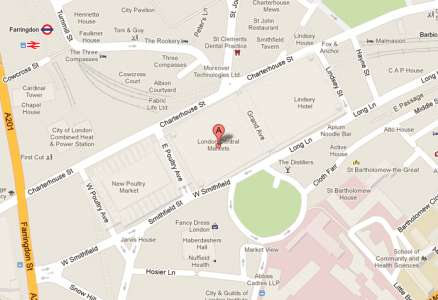One of the most important issues in business is location. Many experts have developed theories about how to determine the most optimal location for its companies, plants and products. Now, within the new era of digital marketing, location definition and strategies have changed.
Here are some recommendations for getting Found online.
Location in business
Location has always been a key factor for different departments within a company. First of all, location was thought in terms of operations and logistics. The first important theory about location was developed by Johann Heinrich von Thünen. Considering variations of rent, transportation costs, land uses and intensities from one territory to another, he developed a model to calculate the best place to set company’s plants.
One of the key persons in highlighting location for retailing was J. Freeman Pyle, who in 1926 wrote about it in the Harvard Business Review. In 1940, Kenneth D. Hutchinson developed a technique to determine the location considering traffic. Many others have formulated theories and carried out studies about consumer behaviour within stores, raising the importance of product location.

In the realm of property, Harold Samuel coined the phrase “location, location, location” as the three things that matter in property. Years later, new theories about determining property value appeared.
Now, in the era of digital marketing, store and product location is a bit different.
Why is location important for businesses?
Location – both branch and product location – is the best way to increase visibility. By setting your store in a highly busy street, or your product at the level of the customer’s eyes, you gain exposure and awareness. Therefore, you have a great chance of people entering into your store or buying your product.

The alternative of a good location is earning awareness with advertising or word of mouth. The first one will cost you a lot of money, and the second one, a lot of time. Both require you to offer consumers something they really value because it will cost them time and money to go to your store. A store based at a busy location is more convenient to customers than one that is not on their route when shopping, going to work or heading back home.
What are consumers doing online?
To understand what location is in digital terms, we first have to know what consumers do online. Most of the non-work-related online activities can be grouped into one of these 3 areas:
- Entertainment and relationships: activities with the purpose of recreation. Examples: watching videos and movies, visiting social networks, searching products that they never will buy like fashion designers clothes, etc.
- Purchasing: all the activities related to purchasing. From getting information about products or services to post-purchase services such as how to use or repair a product.
- Knowledge acquisition: any activity that increases knowledge. This can be reading newspapers or watching an interview related to a specific topic. It includes “how to” articles and videos within categories like cooking, DIY and repairing.
What is location in digital marketing?
Considering these three areas, location in digital marketing is about placing your business or product in the customer’s “online path” to increase visibility and awareness. At the same time, it is also about being convenient for the customer when they are taking part in some of these activities.
When customers are performing an activity that involves a high level of concentration or involvement, they might be reluctant to be interrupted, and may simply choose to ignore you. It’s worth noting this, as it can negatively affect your brand’s likability and can be a waste of money.
Brand recall vs. brand recognition
Brand recall is the process of thinking of a brand when being asked about a category. The digital world gives more importance than ever to brand recall since there are no physical streets for consumers to be walking upon. Rather, if consumers are looking for a product, they will first check the suppliers at the top-of-mind. If they don’t have one in that particular category, or if they want to compare brands, they will ask their friends, seek out opinions by influencers or will look at search engines.
As well, brand recognition is important both within an online store and at all the digital channels available. If a brand is recognised when browsing social networks or when performing a search, there is more of a chance of the site being clicked and visited.
How to improve location in a digital world?
Since the internet has made it very easy to go from one store to another, it is key to develop a complete strategy throughout the different digital channels in order to increase brand awareness, brand recognition and brand recall.
Not only do you have to be a master in positioning your company/products on search engines through SEO and search advertising, but you also have to increase and maintain brand awareness through other tools like content marketing, referrals, email and social media. One such way of doing this is through affiliate marketing, a tool which can increase the digital footprint of your store and products and therefore, your sales.
To increase your sales, two things must be carried out: a consumer analysis and a brand experience model. First of all, a complete analysis of the consumer must be done, including their values and preferences, their buying decision process and their influencers.
Afterwards, a brand experience model must be developed. This model is a representation of the different experiences a customer has with a brand. These experiences are called points of contact. A point of contact might be, among others, an advertisement, a call from the sales department, the use of the product, etc. With this model, a brand is able to determine which of these points of contact are the most relevant in the buying decision process, and, therefore, assign more resources to the most profitable ones.
References
Location in logistics:
Crosier, Scott. Johann-Heinrich von Thünen: Balancing Land-Use Allocation with Transport Cost. CSISS.
Krumme, Gunter. Johann-Heinrich von Thünen (Resources). University of Washington.
Location in property management:
Pearson, Thomas D. Location! Location! Location! What is location? Appraisal Journal, 1991.
Location in retailing:
Pyle, J. Freeman. The determination of location standards for retail concerns. Harvard Business Review, 1926.
Hutchinson, Kenneth D. Traffic and trade correlations: A technique in store location. Journal of Marketing, 1940.
Kirby, Audrey. The architectural design of UK supermarkets 1950-2006. PhD Thesis, University of the Arts London, 2008.
Location in digital marketing:
Agarwal et al. Location, location, location: An analysis of profitability of position in online advertising markets. Journal of Marketing Research, 2011.
Brand management:
Iglesias, O.; Singh, J. J. & Batista-Foguet, J. M. (2011). The role of brand experience and affective commitment in determining brand loyalty. Journal of Brand Management, 18(8), 570-582.
If you’re interested in how Found could supercharge your digital performance across SEO, PPC, Social and Digital PR, then get in touch today to speak to a member of the team.


